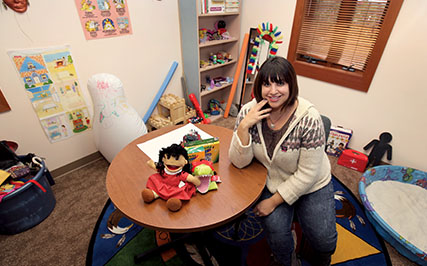Health & Education
Behavioral Health offerings expand for Tribal youth

Nicole Estrada is giving Tribal families more kinds of help for behavioral problems affecting the very youngest. In March, she was named Youth Mental Health and Chemical Dependency counselor in the Behavioral Health Program.
Today, she says, the department has an improved play room. It is set up primarily for children 3 to 10 years old. It includes a sandbox -- "the number one recommended toy," Estrada says -- and other therapy-driven toys.
Toys such as doctor bags and tea sets allow children to express nurturing. Bop bags and plastic guns allow children to express aggression, Estrada said. Puppets give children the chance to safely act out what they are feeling and shelves in the room are packed with "talking, feeling, doing" games.
Children often act the opposite of adults in cases of depression, Estrada said. An adult might be lethargic while a child might be aggressive, but, of course, she noted, that individuals often react differently.
Success may also look different for every client.
"Children can't verbalize loss and grief," Estrada said. "This is why we have play therapy for children where we might have talk therapy for adults. The idea behind play therapy is, 'playing is communication and toys are the words.' "
One young child, facing the loss of a friend, shows no outward sign of grief, but in the play room he gets to act it out through play.
This is "child-centered play therapy, driven by the kids," she said. "I don't go in with an agenda. That gives them the freedom of expression."
Art- and play-therapy is effective with older youth as well, but as children get older a multitude of issues contribute to an overall problem. Some issues, like alcohol and drug use, benefit from group interaction.
The department is also moving toward initiating self-esteem groups.
The goal of therapy is to "see a reduction in unwanted behaviors," Estrada said. This comes about with improvement in family communication and a more satisfying family environment, leading to greater self-esteem.
"If you see those things improve, the unwanted behaviors will disappear," she said.
Estrada works with a number of related departments on campus, including Youth Education, Youth Prevention and Head Start to get to know the children in those programs, to let them know they have options and hopefully to make sure they are comfortable enough to come see her if a need arises.
One of her overriding goals is "stopping the stigma of therapy."
All of the approximately 25 to 30 youth who see Estrada participate with the agreement and involvement of parents. Of those clients, about a third are 20 to 24 years old, a third are 10 years into the teens, and a little less than a third are mostly 3 to 5 year olds.
Estrada grew up as a Southern California member of the Tribe.
"I was the first in my family to go to college and get a degree," she said. "It only was possible because of the help of my family and the Tribe.
"I went to school to be a marriage and family therapist," she said, but when she studied drug and alcohol treatment at Phillips Graduate Institute in Chatsworth, Calif., "The light bulb went off and I knew that's where I need to be."
She graduated from California State University Northridge, where she majored in psychology and minored in American Indian studies.
Her early work took her to a residential center where her clients came from the gangs of Los Angeles.
"I loved it. I absolutely loved it. I was being promoted to run the drug treatment program, but by then I knew I wanted to give back to the Tribe, and put out the word at the Tribe that if anything opens up."
She is a dedicated exerciser, taking advantage of all the Tribal fitness programs: "Spinning I love."
She is also taking in the beauty of the state, the farmers' markets "and helping resurrect my culture is the cherry on the sundae for me. I get to give back and learn myself."
Her boyfriend, she said, "Gave up everything to come north and be with me." They live in Sherwood.
"Reconnecting with my summer family has been amazing," she said. "There have been so many benefits to moving here."
